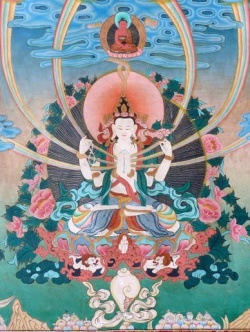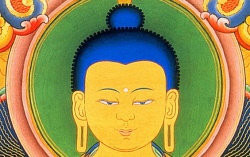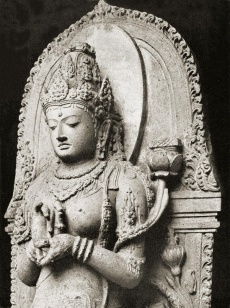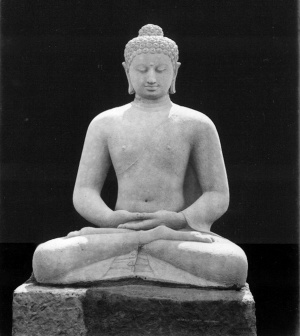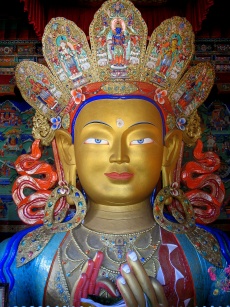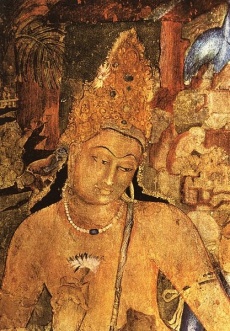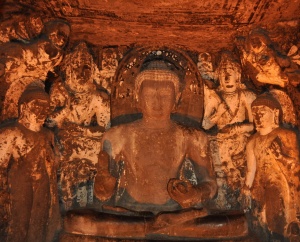Mahayana
Click here to see other articles relating to word Mahayana
Mahayana (Skt. mahāyāna; Tib. ཐེག་ཆེན་ tekpa chenpo; Wyl. theg pa chen po) — the great or universal vehicle. The essence of the mahayana is the aspiration to attain buddhahood as the only means to help all beings find liberation from suffering. This aspiration is called bodhichitta, the ‘heart of enlightened mind’, and is realized on both an absolute and relative level. Mahāyāna (Sanskrit: महायान mahāyāna, literally the "Great Vehicle") is one of the two main existing branches of Buddhism and a term for classification of Buddhist philosophies and practice. Mahāyāna Buddhism originated in India. The Mahāyāna tradition is the larger of the two major traditions of Buddhism existing today, the other being that of the Theravāda school. According to the teachings of Mahāyāna traditions, "Mahāyāna" also refers to the path of seeking complete enlightenment for the benefit of all sentient beings, also called "Bodhisattvayāna", or the "Bodhisattva Vehicle.
Mahàyàna, meaning the ‘the Great Way,’ is a general name for schools of Buddhism that began to evolve around the first millennium, some 500 years after the Buddha.
The original impetus for the development of Mahàyàna was a legitimate unease about the increasing quietism, self-absorption and over-emphasis of monasticism within early Buddhist schools. While some Mahàyàna concepts are logical developments of the Buddha’s teachings and others are unique, although not contrary with the Buddha’s teachings, there are others that reflect the distinct influence of Hinduism.
In time, Mahàyàna absorbed even more Hindu concepts and this led to yet another movement within Buddhism called Vajrayana. Today Mahàyana is practised in Vietnam, China, Korea, Japan and in various Chinese communities around the world. Over the centuries the different schools of Buddhism often engaged in vigorous debates with one another, but there are very few examples where this led to persecution.
Teachings
Central to the Mahayana is the teaching on emptiness or shunyata as set forth in the Prajnaparamita sutras and elaborated upon in the writings of Nagarjuna and his followers.
Literature
Mahayana sutras include large texts such as the Avatamsaka Sutra or the Lotus Sutra, and the important collection of Prajnaparamita sutras. The most important Mahayana treatises are those composed by Nagarjuna and Asanga.
Subschools
The two major branches of philosophy within the Mahayana are the Middle Way (Skt. Madhyamika) and the Mind Only (Skt. Cittamatra).
Alternative Translations
Source
Mahāyāna (Sanskrit: महायान mahāyāna, literally the "Great Vehicle") is one of the two main existing branches of Buddhism and a term for classification of Buddhist philosophies and practice. Mahāyāna Buddhism originated in India, and is associated with the oldest historical sect of Buddhism, the Mahāsāṃghika.
The Mahāyāna tradition is the larger of the two major traditions of Buddhism existing today, the other being that of the Theravāda school. According to the teachings of Mahāyāna traditions, "Mahāyāna" also refers to the path of seeking complete enlightenment for the benefit of all sentient beings, also called "Bodhisattvayāna", or the "Bodhisattva Vehicle".
In the course of its history, Mahāyāna Buddhism spread from India to various other Asian countries such as China, Japan, Vietnam, Korea, Singapore, Taiwan, Nepal, Tibet, Bhutan, and Mongolia. Major traditions of Mahāyāna Buddhism today include Zen/Chán, Pure Land, Tiantai, and Nichiren, as well as the Esoteric Buddhist traditions of Shingon, Tendai and Tibetan Buddhism.
Etymology
According to Jan Nattier, the term Mahāyāna ("Great Vehicle") was originally an honorary synonym for Bodhisattvayāna ("Bodhisattva Vehicle") — the vehicle of a bodhisattva seeking buddhahood for the benefit of all sentient beings. The term Mahāyāna was therefore formed independently at an early date as a synonym for the path and the teachings of the bodhisattvas. Since it was simply an honorary term for Bodhisattvayāna, the creation of the term Mahāyāna and its application to Bodhisattvayāna did not represent a significant turning point in the development of a Mahāyāna tradition.
The earliest Mahāyāna texts often use the term Mahāyāna as a synonym for Bodhisattvayāna, but the term Hīnayāna is comparatively rare in the earliest sources. The presumed dichotomy between Mahāyāna and Hīnayāna can be deceptive, as the two terms were not actually formed in relation to one another in the same era.
Among the earliest and most important references to the term Mahāyāna are those that occur in the Lotus Sutra (Skt. Saddharma Puṇḍarīka Sūtra) dating between the 1st century BCE and the 1st century CE. Seishi Karashima has suggested that the term first used in an earlier Gandhāri Prakrit version of the Lotus Sūtra was not the term mahāyāna but the Prakrit word mahājāna in the sense of mahājñāna (great knowing). At a later stage when the early Prakrit word was converted into Sanskrit, this mahājāna, being phonetically ambivalent, was mistakenly converted into mahāyāna, possibly due to what may have been a double meaning in the famous Parable of the Burning House, which talks of three vehicles or carts (Skt: yāna).
History
Origins
The origins of Mahāyāna are still not completely understood. The earliest views of Mahāyāna Buddhism in the West assumed that it existed as a separate school in competition with the so-called "Hīnayāna" schools. Due to the veneration of buddhas and bodhisattvas, Mahāyāna was often interpreted as a more devotional, lay-inspired form of Buddhism, with supposed origins in stupa veneration, or by making parallels with the history of the European Protestant Reformation. These views have been largely dismissed in modern times in light of a much broader range of early texts that are now available. These earliest Mahāyāna texts often depict strict adherence to the path of a bodhisattva, and engagement in the ascetic ideal of a monastic life in the wilderness, akin to the ideas expressed in the Rhinoceros Sūtra. The old views of Mahāyāna as a separate lay-inspired and devotional sect are now largely dismissed as misguided and wrong on all counts.
The earliest textual evidence of "Mahāyāna" comes from sūtras originating around the beginning of the common era. Jan Nattier has noted that in some of the earliest Mahāyāna texts such as the Ugraparipṛccha Sūtra use the term "Mahāyāna", yet there is no doctrinal difference between Mahāyāna in this context and the early schools, and that "Mahāyāna" referred rather to the rigorous emulation of Gautama Buddha in the path of a bodhisattva seeking to become a fully enlightened buddha.
There is also no evidence that Mahāyāna ever referred to a separate formal school or sect of Buddhism, but rather that it existed as a certain set of ideals, and later doctrines, for bodhisattvas. Paul Williams has also noted that the Mahāyāna never had nor ever attempted to have a separate Vinaya or ordination lineage from the early schools of Buddhism, and therefore each bhikṣu or bhikṣuṇī adhering to the Mahāyāna formally belonged to an early school. This continues today with the Dharmaguptaka ordination lineage in East Asia, and the Mūlasarvāstivāda ordination lineage in Tibetan Buddhism. Therefore Mahāyāna was never a separate rival sect of the early schools.
The Chinese monk Yijing who visited India in the 7th century CE, distinguishes Mahāyāna from Hīnayāna as follows:
- Both adopt one and the same Vinaya, and they have in common the prohibitions of the five offences, and also the practice of the Four Noble Truths. Those who venerate the bodhisattvas and read the Mahayana sutras are called the Mahāyānists, while those who do not perform these are called the Hīnayānists.
Much of the early extant evidence for the origins of Mahāyāna comes from early Chinese translations of Mahāyāna texts. These Mahāyāna teachings were first propagated into China by Lokaksema, the first translator of Mahāyāna sutras into Chinese during the 2nd century CE
Earliest Mahāyāna sūtras
Some scholars have traditionally considered the earliest Mahāyāna sūtras to include the very first versions of the Prajñāpāramitā series, along with texts concerning Akṣobhya Buddha, which were probably written down in the 1st century BCE in the south of India. Some early Mahāyāna sūtras were translated by the Kuṣāṇa monk Lokakṣema, who came to China from the kingdom of Gandhāra. His first translations to Chinese were made in the Chinese capital of Luoyang between 178 and 189 CE. Some Mahāyāna sūtras translated during the 2nd century CE include the following:
- Aṣṭasāhasrikā Prajñāpāramitā Sūtra
- Vimalakīrti Nirdeśa Sūtra
- Larger Sukhāvatīvyūha Sūtra
- Akṣobhyatathāgatasyavyūha Sūtra
- Ugraparipṛccha Sūtra
- Mañjuśrīparipṛcchā Sūtra
- Drumakinnararājaparipṛcchā Sūtra
- Śūraṅgama Samādhi Sūtra
- Bhadrapāla Sūtra
- Ajātaśatrukaukṛtyavinodana Sūtra
- Kāśyapaparivarta Sūtra
- Lokānuvartana Sūtra
- An early sūtra connected to the Avatamsaka Sutra
Some of these were probably composed in the north of India in the 1st century CE. Thus scholars generally think that the earliest Mahāyāna sūtras were mainly composed in the south of India, and later the activity of writing additional scriptures was continued in the north. However, the assumption that the presence of an evolving body of Mahāyāna scriptures implies the contemporaneous existence of distinct religious movement called "Mahāyāna", may be a serious misstep.

Earliest inscriptions
The earliest stone inscription containing a recognizably Mahāyāna formulation and a mention of the Buddha Amitabha was found in the Indian subcontinent in Mathura, and dated to around 180 CE. Remains of a statue of a Buddha bear the Brahmi inscription: "Made in the year 28 of the reign of king Huvishka, ... for the Buddha Amitabha" (Mathura Museum).
However, this image was in itself extremely marginal and isolated in the overall context of Buddhism in India at the time, and had no lasting or long-term consequences. Evidence of the name "Mahāyāna" in Indian inscriptions in the period before the 5th century is very limited in comparison to the multiplicity of Mahāyāna writings transmitted from Central Asia to China at that time.
These views of a discrepancy between translated texts and epigraphical evidence assume the presence of Mahāyāna as distinct from the "Hīnayāna" schools. This view has been largely disproved in more recent scholarship[citation needed], as Mahāyāna is now recognized as a tradition working within the context of the early Buddhist schools rather than as a separate movement.
Early Mahāyāna Buddhism
During the period of early Mahāyāna Buddhism, four major types of thought developed: Mādhyamaka, Yogācāra, Buddha Nature (Tathāgatagarbha), and Buddhist Logic as the last and most recent. In India, the two main philosophical schools of the Mahāyāna were the Mādhyamaka and the later Yogācāra.
Legacy
Earlier stage forms of Mahāyāna such as the doctrines of Prajñāpāramitā, Yogācāra, Buddha Nature, and the Pure Land teachings are still popular in East Asia. In some cases these have spawned new developments, while in others they are treated in the more traditional syncretic manner. Paul Williams has noted that in this tradition in the Far East, primacy has always been given to study of the sūtras.
Late Mahāyāna Buddhism
Late stage forms of Mahāyāna Buddhism in India are found largely in the schools of Esoteric Buddhism. These were replaced in India and Central Asia after the early millennium by Islam (Sufism etc.) and Hinduism, and in south-east Asia by Theravāda Buddhism from Sri Lanka and Islam. They continue to exist in certain regions of the Himalayas. In contrast to the East Asian traditions, there has been a strong tendency in Tibetan Buddhism and the Himalayan traditions to approach the sūtras indirectly through the medium of exegetical treatises if at all.
Doctrine
Few things can be said with certainty about Mahāyāna Buddhism, especially its early Indian form, other than that the Buddhism practiced in China, Indonesia, Vietnam, Korea, Tibet, and Japan is Mahāyāna Buddhism. Mahāyāna can be described as a loosely bound collection of many teachings with large and expansive doctrines that are able to coexist simultaneously.
Mahāyāna constitutes an inclusive tradition characterized by plurality and the adoption of new Mahāyāna sūtras in addition to the earlier Āgama texts. Mahāyāna sees itself as penetrating further and more profoundly into the Buddha's Dharma. There is a tendency in Mahāyāna sūtras to regard adherence to these sūtras as generating spiritual benefits greater than those that arise from being a follower of the non-Mahāyāna approaches to Dharma. Thus the Śrīmālādevī Sūtra claims that the Buddha said that devotion to Mahāyāna is inherently superior in its virtues to the following the śravaka or pratyekabuddha paths.
The fundamental principles of Mahāyāna doctrine were based on the possibility of universal liberation from suffering for all beings (hence the "Great Vehicle") and the existence of buddhas and bodhisattvas embodying Buddha Nature. The Pure Land school of Mahāyāna simplify the expression of faith by allowing salvation to be alternatively obtained through the grace of the Amitābha Buddha by having faith and devoting oneself to mindfulness of the Buddha. This devotional lifestyle of Buddhism has greatly contributed to the success of Mahāyāna in East Asia, where spiritual elements traditionally relied upon mindfulness of the Buddha, mantras and dhāraṇīs, and reading of Mahāyāna sūtras. In Chinese Buddhism, most monks, let alone lay people, practice Pure Land, some combining it with Chán (Zen).
Most Mahāyāna schools believe in supernatural bodhisattvas who devote themselves to the perfections (Skt. pāramitā), ultimate knowledge (Skt. sarvajñāna), and the liberation of all sentient beings. In Mahāyāna, the Buddha is seen as the ultimate, highest being, present in all times, in all beings, and in all places, and the bodhisattvas come to represent the universal ideal of altruistic excellence.
Universalism
Mahāyāna traditions generally consider that attainment of the level of arhat is not final. This is based on a subtle doctrinal distinction between the Mahāyāna and some views contained in the early Buddhist schools concerning the issues of Nirvāṇa With Remainder and Nirvāṇa Without Remainder. The Mahāyāna position here is similar to that of the early school of the Mahāsāṃghika.
Some of the early schools considered that Nirvāṇa Without Remainder always follows Nirvāṇa With Remainder (Buddhas first achieve enlightenment and then, at "death", Mahāparinirvāṇa) and that Nirvāṇa Without Remainder is final; whereas the Mahāyāna traditions consider that Nirvāṇa Without Remainder is always followed by Nirvāṇa With Remainder — the state of attainment of arhat is not considered final, and should be succeeded by Bodhisattvahood.
This distinction is most evident regarding doctrinal concerns about the capability of a Buddha after Nirvāṇa, which is identified by the early schools as being Nirvāṇa Without Remainder. Amongst the early schools, a completely enlightened buddha (Skt. samyaksaṃbuddha) is not able to directly point the way to Nirvāṇa after death. Some[who?] Mahayana schools however, hold that once a completely enlightened Buddha (Skt. samyaksaṃbuddha) arises, he or she continues to directly and actively point the way to Nirvāṇa until there are no beings left in saṃsāra. Consequently, some Mahāyāna schools talk of a bodhisattva deliberately refraining from Buddhahood. The Lotus Sutra states that Shakyamuni Buddha's parinirvana is an expedient, and that he actually remains in the world to teach and guide living beings. This is why Nichiren Buddhism regards Shakyamuni as the Eternal Buddha.
The early schools held that Maitreya will be the next Buddha to rediscover the path to Nirvana, when teachings of Gautama Buddha are forgotten. In contrast, some Mahāyāna schools hold that Maitreya will be the next buddha manifest in this world and will introduce the Dharma when it no longer exists, but when he dies (or enters Mahāparinirvāṇa), he will likewise continue to teach the Dharma for all time. Moreover, some Mahāyāna schools argue that although it is true that, for this world-system, Maitreya will be the next buddha to manifest, there are an infinite number of world-systems, many of which have currently active buddhas or bodhisattvas manifesting.
Because the Mahāyāna traditions assert that eventually everyone will achieve complete enlightenment (Skt. Anuttarā Samyaksaṃbodhi), the Mahāyāna is labeled universalist, whereas the stance of the early scriptures is that attaining Nirvāṇa depends on effort and is not pre-determined.
Bodhisattva
The Mahāyāna tradition holds that pursuing only the release from suffering and attainment of Nirvāṇa is too narrow an aspiration, because it lacks the motivation of actively resolving to liberate all other sentient beings from Saṃsāra. One who engages in this path is called a bodhisattva.
The defining characteristic of a bodhisattva is bodhicitta, the intention to achieve omniscient Buddhahood (Trikaya) as fast as possible, so that one may benefit infinite sentient beings. Sometimes the term bodhisattva is used more restrictively to refer to those sentient beings on the grounds. As Ananda Coomaraswamy notes, "The most essential part of the Mahayana is its emphasis on the Bodhisattva ideal, which replaces that of the arhat, or ranks before it." According to Mahāyāna teachings, being a high-level bodhisattva involves possessing a mind of great compassion and transcendent wisdom (Skt. prajñā) to realize the reality of inherent emptiness and dependent origination. Mahāyāna teaches that the practitioner will finally realize the attainment of Buddhahood.
Six perfections (Skt. pāramitā) are traditionally required for bodhisattvas:
- dāna-pāramitā: the perfection of giving
- śīla-pāramitā: the perfection on behavior and discipline
- kṣānti-pāramitā: the perfection of forbearance
- vīrya-pāramitā: the perfection of vigor and diligence
- dhyāna-pāramitā: the perfection of meditation
- prajñā-pāramitā: the perfection of transcendent wisdom
Expedient means
See also: Upaya
Expedient means (Skt. upāya) is found in the Lotus Sutra, one of the earliest dated Mahāyāna sūtras, and is accepted in all Mahāyāna schools of thought. It is any effective method that aids awakening. It does not necessarily mean that some particular method is "untrue" but is simply any means or stratagem that is conducive to spiritual growth and leads beings to awakening and nirvana. Expedient means could thus be certain motivational words for a particular listener or even the noble eightfold path itself. Basic Buddhism (what Mahāyāna would term śravakayāna or pratyekabuddhayāna) is an expedient method for helping people begin the noble Buddhist path and advance quite far. But the path is not wholly traversed, according to some Mahāyāna schools, until the practitioner has striven for and attained Buddhahood for the liberation of all other sentient beings from suffering.
Some scholars have stated that the exercise of expedient means, "the ability to adapt one's message to the audience, is also of enormous importance in the Pāli canon." In fact the Pāli term upāya-kosalla does occur in the Pāli Canon, in the Sangiti Sutta of the Digha Nikāya.
Liberation
“Devotional” Mahāyāna developed a rich cosmography, with various Buddhas and bodhisattvas residing in paradise realms. The concept of the three bodies (trikaya) supports these constructions, making the Buddha himself a transcendental figure. Dr. Guang Xing describes the Mahāyāna Buddha as "an omnipotent divinity endowed with numerous supernatural attributes and qualities ...[He] is described almost as an omnipotent and almighty godhead."
Under various conditions, the realms Buddha presides over could be attained by devotees after their death so, when reborn, they could strive towards buddhahood in the best possible conditions. Depending on the sect, this salvation to “paradise” can be obtained by faith, imaging, or sometimes even by the simple invocation of the Buddha’s name. This approach to salvation is at the origin of the mass appeal of devotional Buddhism, especially represented by the Pure Land (浄土宗).
This rich cosmography also allowed Mahāyāna to be quite syncretic and accommodating of other faiths or deities. Various origins have been suggested to explain its emergence, such as “popular Hindu devotional cults (bhakti), and Persian and Greco-Roman theologies, which filtered into India from the northwest”.
Buddha nature
See also: Buddha nature
The teaching of a "Buddha nature" (Skt. tathāgatagarbha) may be based on the "luminous mind" concept found in the Āgamas. The essential idea, articulated in the Buddha nature sūtras, but not accepted by all Mahāyānists, is that no being is without a concealed but indestructible interior link to the awakening of bodhi and that this link is an uncreated element (dhātu) or principle deep inside each being, which constitutes the deathless, diamond-like "essence of the self". The Mahāparinirvāṇa Sūtra states: "The essence of the Self (ātman) is the subtle Buddha nature..." while the later Lankāvatāra Sūtra states that the Buddha nature might be taken to be self (ātman), but it is not. In the 'Sagathakam' section of that same sutra, however, the Tathagatagarbha as the Self is not denied, but affirmed: 'The Atma (Self) characterised with purity is the state of self-realization; this is the Tathagata's Womb (garbha), which does not belong to the realm of the theorisers'.[52] In the Buddha nature class of sūtras, the word "self" (ātman) is used in a way defined by and specific to these sūtras. (See Atman.)
According to some scholars, the Buddha nature discussed in some Mahāyāna sūtras does not represent a substantial self (ātman); rather, it is a positive language and expression of emptiness (śūnyatā) and represents the potentiality to realize Buddhahood through Buddhist practices. It is the "true self" in representing the innate aspect of the individual that makes actualizing the ultimate personality possible.
The actual "seeing and knowing" of this Buddha essence (Buddha-dhātu, co-terminous with the Dharmakāya or self of Buddha) is said to usher in nirvanic liberation. This Buddha essence or "Buddha nature" is stated to be found in every single person, ghost, god and sentient being. In the Buddha nature sūtras, the Buddha is portrayed as describing the Buddha essence as uncreated, deathless and ultimately beyond rational grasping or conceptualisation. Yet, it is this already real and present, hidden internal element of awakeness (bodhi) that, according to the Buddha nature sūtras, prompts beings to seek liberation from worldly suffering, and lets them attain the spotless bliss that lies at the heart of their being. Once the veils of negative thoughts, feelings, and unwholesome behaviour (the kleśas) are eliminated from the mind and character, the indwelling Buddha principle (Buddha-dhātu: Buddha nature) can shine forth unimpededly and transform the seer into a Buddha.
Prior to the period of these sūtras, Mahāyāna metaphysics was dominated by teachings on emptiness, in the form of Madhyamaka philosophy. The language used by this approach is primarily negative, and the Buddha nature genre of sūtras can be seen as an attempt to state orthodox Buddhist teachings of dependent origination and on the mysterious reality of nirvana using positive language instead, to prevent people from being turned away from Buddhism by a false impression of nihilism. In these sūtras the perfection of the wisdom of not-self is stated to be the true self; the ultimate goal of the path is then characterized using a range of positive language that had been used in Indian philosophy previously by essentialist philosophers, but was now transmuted into a new Buddhist vocabulary that described a being who has successfully completed the Buddhist path.
The Uttaratantra (an exegetical treatise on Buddha nature) sees Buddha nature not as caused and conditioned (saṃskṛta), but as eternal, uncaused, unconditioned, and incapable of being destroyed, although temporarily concealed within worldly beings by adventitious defilements. According to Buddhist scholar Dr. C. D. Sebastian, the Uttaratantra's reference to a transcendental self (ātma-pāramitā) should be understood as "the unique essence of the universe," thus the universal and immanent essence of Buddha nature is the same throughout time and space.
Scriptures
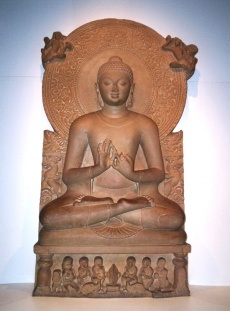
Āgamas
See also: Mahayana sutras
Mahāyāna Buddhism takes the basic teachings of the Buddha as recorded in early scriptures as the starting point of its teachings, such as those concerning karma and rebirth, anātman, emptiness, dependent origination, and the Four Noble Truths. Mahāyāna Buddhists in East Asia have traditionally studied these teachings in the Āgamas preserved in the Chinese Buddhist canon. "Āgama" is the term used by those traditional Buddhist schools in India who employed Sanskrit for their basic canon. These correspond to the Nikāyas used by the Theravāda school. The surviving Āgamas in Chinese translation belong to at least two schools, while most of the Āgamas teachings were never translated into Tibetan.
In addition to accepting the essential scriptures of the various early Buddhist schools as valid, Mahāyāna Buddhism also maintains large additional collections of sūtras that are not used or recognized by the Theravāda school. In the past, these were also not recognized by some individuals within the early Buddhist schools. In other cases, Buddhist communities were divided along these doctrinal lines. In Mahāyāna Buddhism, the Mahāyāna sūtras are often given greater authority than the Āgamas. The first of these Mahāyāna-specific writings were written probably around the 1st century BCE or 1st century CE.
Turnings of the Dharma Wheel
Dating back at least to the Saṃdhinirmocana Sūtra is a classification of the corpus of Buddhism into three categories, based on ways of understanding the nature of reality, known as the "Three Turnings of the Dharma Wheel". According to this view, there were three such "turnings":
- In the first turning, the Buddha taught the Four Noble Truths at Vārāṇasī for those in the śravaka vehicle. It is described as marvelous and wonderful, but requiring interpretation and occasioning controversy. The doctrines of the first turning are exemplified in the Dharmacakra Pravartana Sūtra. This turning represents the earliest phase of the Buddhist teachings and the earliest period in the history of Buddhism.
- In the second turning, the Buddha taught the Mahāyāna teachings to the bodhisattvas, teaching that all phenomena have no-essence, no arising, no passing away, are originally quiescent, and essentially in cessation. This turning is also described as marvelous and wonderful, but requiring interpretation and occasioning controversy. Doctrine of the second turning is established in the Prajñāpāramitā teachings, first put into writing around 100 BCE. In Indian philosophical schools, it is exemplified by the Mādhyamaka school of Nāgārjuna.
- In the third turning, the Buddha taught similar teachings to the second turning, but for everyone in the three vehicles, including all the śravakas, pratyekabuddhas, and bodhisattvas. These were meant to be completely explicit teachings in their entire detail, for which interpretations would not be necessary, and controversy would not occur. These teachings were established by the Saṃdhinirmocana Sūtra as early as the 1st or 2nd century CE. In the Indian philosophical schools, the third turning is exemplified by the Yogācāra school of Asaṅga and Vasubandhu.
Some traditions of Tibetan Buddhism consider the teachings of Esoteric Buddhism and Vajrayāna to be the third turning of the Dharma Wheel. Tibetan teachers, particularly of the Gelugpa school, regard the second turning as the highest teaching, due to their particular interpretation of Yogācāra doctrine. The Buddha Nature teachings are normally included in the third turning of the wheel. The Chinese tradition has a different scheme.
The Chinese scholar T'ien-T'ai believed the Buddha taught over Five Periods. These are:
- The Flower Garland Period.
- The Agama Period.
- The Correct and Equal Period (provisional Mahayana Sutras, including the Amida, Mahavairochana and Vimalakirti Sutras).
- The Wisdom Period (Perfection of Wisdom Sutras).
- The Lotus and Nirvana Period (when Shakyamuni taught from the standpoint of his Enlightenment)
Early canon
Scholars have noted that many key Mahāyāna ideas are closely connected to the earliest texts of Buddhism. The seminal work of Mahāyāna philosophy, Nāgārjuna's Mūlamadhyamakakārikā, mentions the canon's Katyāyana Sūtra by name, and may be an extended commentary on that work. Nāgārjuna systematized the Mādhyamaka school of Mahāyāna philosophy. He may have arrived at his positions from a desire to achieve a consistent exegesis of the Buddha's doctrine as recorded in the canon. In his eyes the Buddha was not merely a forerunner, but the very founder of the Mādhyamaka system. Nāgārjuna also referred to a passage in the canon regarding "nirvanic consciousness" in two different works.
Yogācāra, the other prominent Mahāyāna school in dialectic with the Mādhyamaka school, gave a special significance to the canon's Lesser Discourse on Emptiness . A passage there (which the discourse itself emphasizes) is often quoted in later Yogācāra texts as a true definition of emptiness. According to Walpola Rahula, the thought presented in the Yogācāra school's Abhidharma-samuccaya is undeniably closer to that of the Pali Nikayas than is that of the Theravadin Abhidhamma.
Both the Mādhyamikas and the Yogācārins saw themselves as preserving the Buddhist Middle Way between the extremes of nihilism (everything as unreal) and substantialism (substantial entities existing). The Yogācārins criticized the Mādhyamikas for tending towards nihilism, while the Mādhyamikas criticized the Yogācārins for tending towards substantialism.
Key Mahāyāna texts introducing the concepts of bodhicitta and Buddha nature also use language parallel to passages in the canon containing the Buddha's description of "luminous mind" and may have been based on this idea.
Theravāda school
Role of the Bodhisattva
In the early Buddhist texts, and as taught by the modern Theravada school, the goal of becoming a teaching Buddha in a future life is viewed as the aim of a small group of individuals striving to benefit future generations after the current Buddha's teachings have been lost, but in the current age there is no need for most practitioners to aspire to this goal. Theravada texts do, however, hold that this is a more perfectly virtuous goal.
Theravāda and Hīnayāna
Although the Theravāda school is usually described as belonging to Hīnayāna, some authors have argued that it should not be considered such from the Mahāyāna perspective. Their view is based on a different understanding of the concept of Hīnayāna. Rather than regarding the term as referring to any school of Buddhism that hasn't accepted the Mahāyāna canon and doctrines, such as those pertaining to the role of the boddhisatva, these authors argue that the classification of a school as "Hīnayāna" should be crucially dependent on the adherence to a specific phenomenological position. They point out that unlike the now-extinct Sarvāstivāda school, which was the primary object of Mahāyāna criticism, the Theravāda does not claim the existence of independent entities (dharmas); in this it maintains the attitude of early Buddhism. Adherents of Mahāyāna Buddhism disagreed with the substantialist thought of the Sarvāstivādins and Sautrāntikas, and in emphasizing the doctrine of emptiness, Kalupahana holds that they endeavored to preserve the early teaching. The Theravādins too refuted the Sarvāstivādins and Sautrāntikas (and other schools) on the grounds that their theories were in conflict with the non-substantialism of the canon. The Theravāda arguments are preserved in the Kathāvatthu. Thus, according to this view, no form of real Hīnayāna Buddhism survives today.
Some contemporary Theravādin figures have indicated a sympathetic stance toward the Mahāyāna philosophy found in texts such as the Heart Sūtra (Skt. Prajñāpāramitā Hṛdaya) and Nāgārjuna's Fundamental Stanzas on the Middle Way (Skt. Mūlamadhyamakakārikā).
